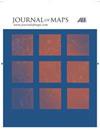聂鲁达四边形的地质(H13),水星
IF 2.1
4区 地球科学
Q2 GEOGRAPHY
引用次数: 0
摘要
我们展示了水星聂鲁达四边形(H13)的第一张地质图。H13位于水星的南半球,在纬度22.5°S - 65°S,经度90°E-180°之间,总面积不到500万平方公里,相当于水星表面的6.5%。地图数字化以1:30万至1:70万的比例进行,最终以1:30万的比例呈现,这些数据来自美国宇航局信使号任务的任务结束数据产品。我们区分了三个主要的光地质平原单位:火山口间平原、中间平原和平滑平原。我们还根据陨石坑的降解状态来区分直径≥20 km的陨石坑及其材料。我们已经完成了两个版本的地图,一个使用三级火山口降解方案,另一个使用五级火山口降解方案。此外,还绘制了伦勃朗撞击盆地的具体地质单元图。这张地图为ESA-JAXA的BepiColombo水星任务提供了背景和目标。本文章由计算机程序翻译,如有差异,请以英文原文为准。
Geology of the Neruda quadrangle (H13), Mercury
We present the first geological map of the Neruda Quadrangle (H13), Mercury. H13 is in Mercury’s southern hemisphere between latitudes 22.5°S–65°S, and longitudes 90°E–180° covering a total area of just under 5 million km², equivalent to 6.5% of the planet’s surface. Map digitisation was carried out at scales between 1:300,000 and 1:700,000 for final presentation at 1:3,000,0000, from end-of-mission data products from NASA’s MESSENGER mission. We distinguish three main photogeologic plains units: intercrater, intermediate, and smooth plains. We also distinguish all craters and their materials ≥ 20 km in diameter based on their degradation state. We have completed two versions of the map, one using a three-class crater degradation scheme and one using a five-class crater degradation scheme. In addition, specific geological units were charted for the Rembrandt impact basin. This map has been constructed to provide context and targets for the ESA-JAXA BepiColombo mission to Mercury.
求助全文
通过发布文献求助,成功后即可免费获取论文全文。
去求助
来源期刊

Journal of Maps
地学-自然地理
CiteScore
4.30
自引率
9.10%
发文量
83
审稿时长
6-12 weeks
期刊介绍:
The Journal of Maps is a peer-reviewed, inter-disciplinary, online journal that aims to provide a forum for researchers to publish maps and spatial diagrams.
 求助内容:
求助内容: 应助结果提醒方式:
应助结果提醒方式:


